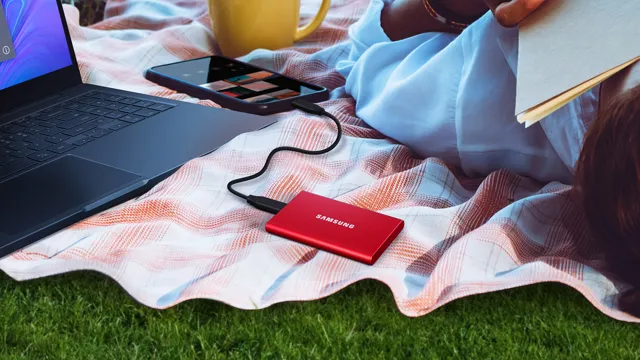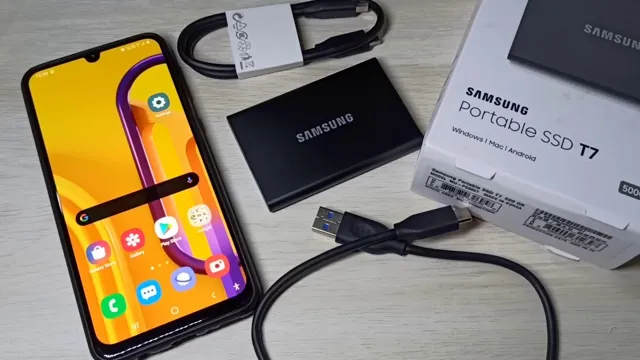Have you recently upgraded to a Samsung SSD T7 and are now wondering how to transfer your valuable files? Look no further, as we’ve got you covered. With its lightning-fast speed and reliable storage capacity, the Samsung SSD T7 is a great choice for anyone looking to enhance their computer’s performance. But transferring files to a new SSD can be a daunting task, especially if you’re not tech-savvy.
In this blog post, we’ll provide you with step-by-step instructions on how to transfer your files to your Samsung SSD T7, whether you’re using a Windows or MacOS system. By the end of this post, you’ll be ready to make the most out of your new SSD and enjoy lightning-fast performance without losing any of your precious data. So, sit back, relax, and let’s get started!
Connect SSD to your device
If you want to transfer files to your Samsung SSD T7, the process is straightforward and user-friendly. First, ensure your device has a USB-C port or an adapter to connect to your SSD. Plug your SSD into your device via the USB cable provided, and wait for it to connect.
Once it does, you can open up your file explorer and drag and drop your files onto the SSD. Alternatively, you can use the Samsung Portable SSD software to manage and transfer your files. This software allows you to password protect your files and perform firmware updates.
It also offers a backup and restores feature for added security. Transferring files to your Samsung SSD T7 is swift, with read and write speeds of up to 1,050MB/s. So whether you’re transferring important documents, photos, or videos, you can trust your Samsung SSD T7 to make the process seamless and efficient.
Using USB-C to USB-A cable
If you’re looking to connect your SSD to your device, using a USB-C to USB-A cable is a great option. This type of cable allows you to transfer data quickly and efficiently. Plus, it’s easy to use! Just plug one end into your device’s USB-C port and the other end into the USB-A port on your SSD.
Whether you’re transferring photos, videos, or documents, this cable can handle it with ease. The USB-C end can transfer data at speeds of up to 10 Gbps, which is more than enough for most users. Plus, it’s compatible with a wide range of devices, including laptops, desktops, and smartphones.
Overall, if you’re in need of a reliable and fast way to connect your SSD to your device, a USB-C to USB-A cable is definitely worth considering. It’s an affordable and convenient tool that can make transferring data a breeze.

Using USB-C to USB-C cable
If you want to connect your SSD to your device, one of the easiest and most efficient ways to do so is by using a USB-C to USB-C cable. Not only is this cable widely available, but it’s also capable of transferring data at high speeds, making it perfect for quickly transferring large files or backing up your important data. Simply plug one end of the cable into your device’s USB-C port and the other end into your SSD’s USB-C port.
Once connected, you should be able to access your SSD’s contents just like you would with any other external storage device. Whether you’re a professional photographer with lots of high-resolution images to store or simply looking for a reliable way to back up your important files, using a USB-C to USB-C cable is an excellent choice for connecting your SSD to your device.
Install Samsung Portable SSD Software
If you want to transfer files to your Samsung SSD T7, the first step you need to take is to install the Samsung Portable SSD software on your computer. This software will allow you to manage and access your files on the SSD, as well as enable you to encrypt your data to ensure its security. To download the software, simply visit the Samsung website and select the ‘Support’ tab.
From there, you can search for your specific SSD model and download the relevant software. Once the software is installed, you can connect your SSD to your computer, and transfer files between the two using the intuitive interface provided by the Samsung Portable SSD software. With its lightning-fast transfer speeds and intuitive interface, using the Samsung SSD T7 has never been more convenient.
Download and install software on your device
If you have purchased a Samsung Portable SSD, then you must install the Samsung Portable SSD Software to optimize the device’s performance. The software is free to download and can be easily installed on your computer or laptop. Once the software is installed, it enables the user to manage and configure the Samsung Portable SSD device and also provides data security through password protection.
The Samsung Portable SSD Software can be downloaded from the official Samsung website or through the Samsung Portable SSD product page. The installation process is straightforward, and the software is compatible with both Windows and Mac operating systems. So, don’t wait any longer, download and install the Samsung Portable SSD Software and take your device to the next level.
Connect SSD and launch software
If you’ve purchased a brand new Samsung Portable SSD and are ready to start using it, one of the first things you’ll need to do is download and install the accompanying Samsung Portable SSD software. This software will help you manage and optimize your SSD, providing you with important information about its performance and ensuring that it’s always running at its best. Before downloading the software, make sure that your SSD is properly connected to your computer.
Once you’ve done that, simply navigate to the Samsung website and find the software download page. From there, you’ll be able to access the appropriate software for your particular model of SSD and begin the installation process. The software is easy to use and intuitive, and it will help ensure that you’re getting the best possible performance out of your Samsung Portable SSD.
Transfer files to SSD
If you’re looking to transfer files to your Samsung SSD T7, there are a few easy steps to follow. First, connect the SSD to your computer via USB. Then, ensure that the SSD is recognized by your computer by checking that it appears in the device list or File Explorer.
Once recognized, simply drag and drop the files you want to transfer from your computer onto the SSD. You can transfer individual files or entire folders, depending on your needs. The T7 is a reliable and fast storage option for those looking to increase their data transfer speeds, and it’s easy to use with simple plug-and-play functionality.
With these simple steps, you can quickly and easily transfer your files to your Samsung SSD T7 and enjoy fast, reliable storage.
Using drag and drop method
If you’ve recently upgraded to an SSD, you might be wondering how to transfer your files. Fortunately, the process is straightforward, and you can do it using the simple drag and drop method. All you need to do is connect the SSD to your computer and open both the source and destination folders.
From there, you can simply select the files you want to transfer and drag them over to the SSD. You can also use the option to copy and paste the files if you prefer. With this method, you don’t need any special software, and it’s a quick and easy way to move your important files to your new SSD.
So, get started on transferring your files and experiencing the improved performance of your SSD!
Using Samsung Portable SSD Software
If you’re looking for a way to transfer your files quickly and efficiently onto your Samsung Portable SSD, you’re in luck – the Samsung Portable SSD software makes the process easy and hassle-free. With this software, you can simply drag and drop your files from your computer onto the SSD, or choose to use the Auto Backup feature to automatically copy important files onto the drive. This is especially handy for those who need to transfer large files, such as hi-res photos or 4K video projects, as the Samsung Portable SSD has incredibly fast data transfer speeds.
So whether you’re a content creator, photographer, or simply need a reliable backup solution for your important files, the Samsung Portable SSD with its accompanying software is a great choice.
Safely eject SSD
If you’re looking to transfer files to your Samsung T7 SSD, it’s actually a quick and easy process. First, connect your SSD to your computer via the USB cable that comes with the device. You should see the device appear on your desktop or in your file explorer.
Next, simply drag and drop the files you want to transfer onto the Samsung T7 SSD icon. Depending on the size of the files being transferred, the process may take a few minutes to complete. Once finished, be sure to safely eject the SSD by right-clicking on the icon and selecting “Eject” to avoid any data corruption or loss.
The Samsung T7 SSD is a great option for anyone looking for reliable, high-speed external storage. And with this simple transfer process, you can easily back up your files or take them with you on the go.
Conclusion
Transferring files to your Samsung SSD T7 is as easy as pie once you follow these simple steps. Whether you’re looking to speed up your gaming experience or store your precious memories, the T7 provides lightning-fast transfer speeds and ample storage space. So, say goodbye to waiting around for hours to transfer your files and hello to a world of seamless data storage with the Samsung SSD T
“
FAQs
How do I transfer files to Samsung SSD T7?
You can transfer files to Samsung SSD T7 using the included USB Type-C to Type-C cable. Simply connect one end of the cable to your SSD and the other end to your computer. Then drag and drop the files you want to transfer to your SSD.
Can I transfer large files to Samsung SSD T7?
Yes, you can transfer large files to Samsung SSD T7. The T7 has blazing-fast read/write speeds of up to 1050/1000 MB/s, which makes transferring large files a breeze. Just make sure you have enough space on your SSD to accommodate the files you want to transfer.
What is the maximum storage capacity of Samsung SSD T7?
The Samsung SSD T7 is available in three different storage capacities: 500GB, 1TB, and 2TB. Depending on your storage needs, you can choose the capacity that best suits you.
Is it compatible with MacOS and Windows?
Yes, Samsung SSD T7 is compatible with both MacOS and Windows. You may need to reformat the SSD if you plan to use it exclusively with either MacOS or Windows, but the T7 comes with a simple step-by-step guide that makes this process easy.
